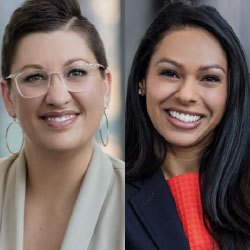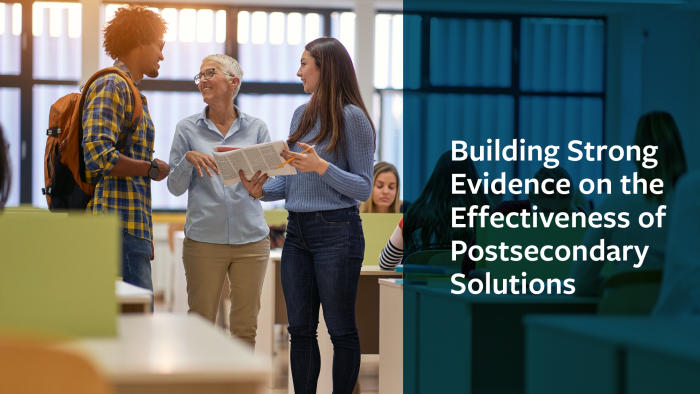
Investing in Projects that Support Adult Learners
 Whether contemplating if completing additional education will make them more attractive to employers in high-demand fields or considering a transition into a new career altogether, many adults are looking for ways to enhance their talents by returning to postsecondary education.
Whether contemplating if completing additional education will make them more attractive to employers in high-demand fields or considering a transition into a new career altogether, many adults are looking for ways to enhance their talents by returning to postsecondary education.
These adult learners are attempting to navigate a postsecondary world in which they are considered a “non-traditional student.” On top of these challenges, they may also be balancing full- or part-time work, unemployment or have childcare responsibilities. They may also have some college, no degree or have some postsecondary credentials, but are unsure where to start as they continue on their educational journey.
Senior Program Officer Carolynn Lee and Program Officer Maryann Rainey in our Streamline Key Learner Transitions focus area share their thoughts on this distinct population of learners — and why it’s so important to make investments that smooth educational and workforce transitions for them.
Why is Ascendium interested in investing in projects that increase degree and credential completion for adult learners?
Maryann: Ascendium is committed to elevating opportunities through the transformative power of education and training for everyone, especially those from economically marginalized backgrounds. Learners who started college but left before they earned a degree don’t have the economic and professional benefits of a postsecondary credential, and they may also be burdened with the debts of their previous postsecondary experiences. These adult learners deserve the opportunity to return and complete their credential to have the opportunity to transform their own lives, their families and their communities. We understand, however, that there are real barriers that impede their success when they return, such as balancing working and learning, their access to childcare and flexible program options that are aligned with their career interests.
How can postsecondary institutions provide comprehensive services that resonate with all types of adult learners, regardless of their background or prior learner experience?
Carolynn: I think the key word here is comprehensive. Siloed efforts, within and even between institutions, are simply not effective at improving outcomes at scale. Lasting institutional change happens under conditions of sustained, campus-wide commitment, and this requires buy-in from administrators, faculty and staff alike. There are, of course, key actions we know that can be catalytic in creating a campus culture that is more supportive for low-income learners in transition — especially returning adults — but singular efforts, absent a more comprehensive strategy rooted in equity, will produce only limited impact.
Maryann: At the institutional level, students need to receive supports that are unique to their context and needs. From our work with the Tennessee Board of Regents, we learned that adult learners’ first term of enrollment upon reconnecting is a critical point in their path to completing a postsecondary credential. After returning, fewer than half of students persisted to the next year and course success rates were lower in gateway courses, such as math and English. It’s important for institutions to first understand how returning learners are navigating these pivotal moments in their journey to completion and then address the barriers that are impeding their success.
What kinds of challenges do adult learners face, particularly those with some college, but no degree, and what can institutions do to better support these learners?
Maryann: If you are an adult learner who is from an economically marginalized community, working full-time, taking care of dependents and juggling multiple demands, time is not of abundance. Institutions need to have flexible course offerings, accelerated degree programs tailored to adults and clear pathways that are connected to learners’ professional pursuits. According to our work with The Graduate! Network, institutions that are successful in attracting adult learners provide advisors who are trained in awarding transfer credit, offer prior learning assessment and embed credentials in degree pathways.
Adult learners also need to see themselves represented in the classroom and know that their institution is not only a welcoming environment, but provides programs and resources tailored to their realities. Institutions that invest in their students’ success often offer emergency grants, implement intrusive advising to proactively engage with adult students and help with non-tuition related costs such as textbooks and childcare.
How can postsecondary institutions embed the ways of working into their policies and practices to set adult learners up for success into the future? How can we ensure solutions are sustainable and are not a one-time response?
Carolynn: This is really the million-dollar question. Post-traditional learners are here to stay, so it’s imperative that colleges and universities don’t treat their responsibility to adult and returning learners as a one-off “initiative” or as a single strategy to increase enrollment. With significant federal investment flowing to institutions of higher education in the form of stimulus funds, and the proposed additional funding included in the American Families Plan, there literally may never again be an opportunity like there is right now. It is crucial that institutional and system leaders prioritize decisions about how to invest in policy and practice reform that centers the needs of learners facing the most obstacles to success. These are also the learners who have the most to gain from completing a postsecondary credential.
The five priorities outlined in Education Strategy Group’s Adult Ready Playbook are a great place to start in order to maximize both available funding and human capital. By targeting improvements to accessibility, program delivery, operational systems, data collection and measurement and partnerships, colleges can make strategic decisions that will impact the outcomes for all students. Then they can begin to close attainment and equity gaps for those who do not have the generational or class advantages that correlate to educational attainment.
How can a comprehensive approach transform postsecondary education to better serve adult learners from low-income backgrounds?
Carolynn: There are around 40 million people in the U.S. with college credit, but no degree, and the majority of these learners are over the age of 30. These potential completers often stopped out before completing a degree because they faced financial hurdles, family responsibilities, academic barriers or some combination of these realities. While not all adult learners are from low-income backgrounds, and not all low-income students are what we would consider post-traditional, the Venn diagram contains significant overlap, and creating a more equitable educational environment that supports returning adults’ success will in fact improve outcomes for all learners.


